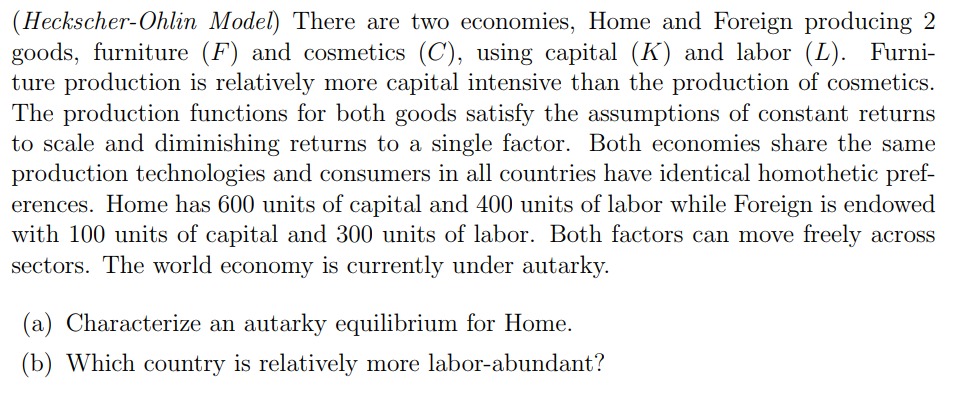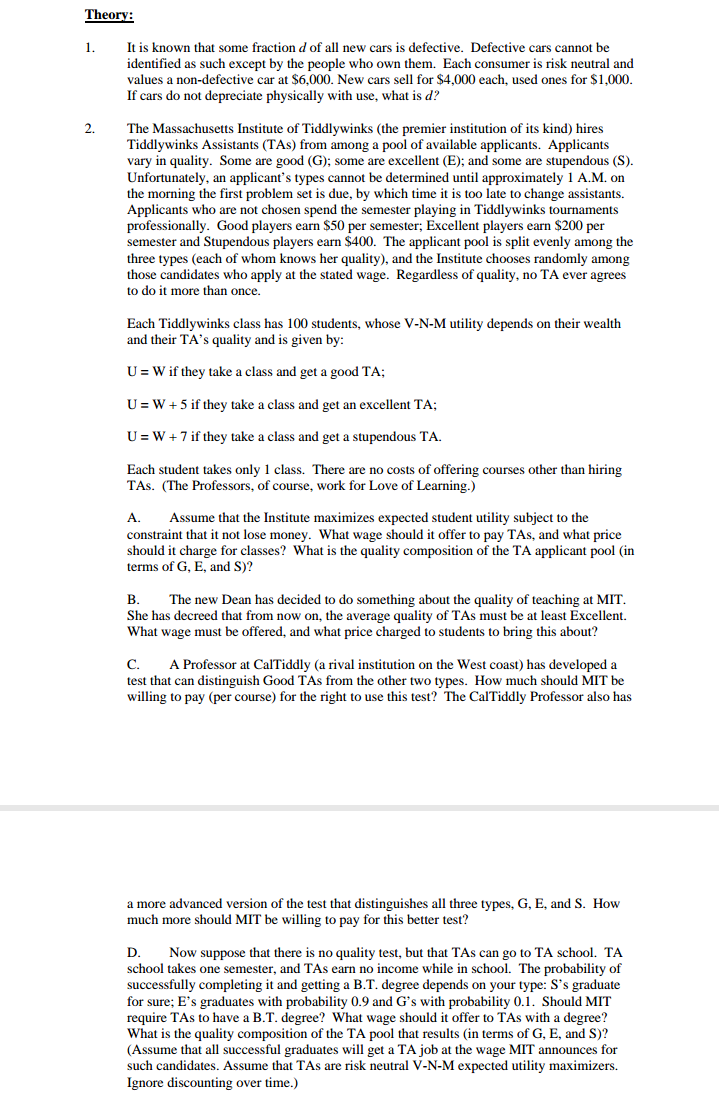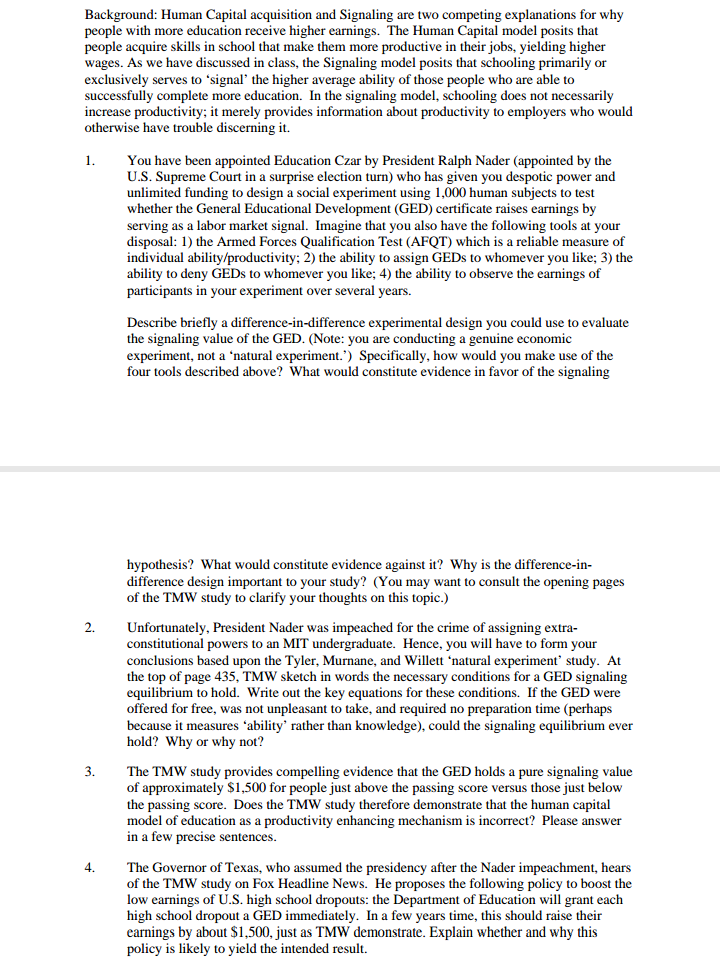


Solve the following questions
( Heckscher-Ohlin Model) There are two economies, Home and Foreign producing 2 goods, furniture (F) and cosmetics (C), using capital (K ) and labor (L). Furni- ture production is relatively more capital intensive than the production of cosmetics. The production functions for both goods satisfy the assumptions of constant returns to scale and diminishing returns to a single factor. Both economies share the same production technologies and consumers in all countries have identical homothetic pref- erences. Home has 600 units of capital and 400 units of labor while Foreign is endowed with 100 units of capital and 300 units of labor. Both factors can move freely across sectors. The world economy is currently under autarky. (a) Characterize an autarky equilibrium for Home. (b) Which country is relatively more labor-abundant?( Heckscher-Ohlin Model) There are two economies, Home and Foreign producing 2 goods, furniture (F) and cosmetics (C), using capital (K ) and labor (L). Furni- ture production is relatively more capital intensive than the production of cosmetics. The production functions for both goods satisfy the assumptions of constant returns to scale and diminishing returns to a single factor. Both economies share the same production technologies and consumers in all countries have identical homothetic pref- erences. Home has 600 units of capital and 400 units of labor while Foreign is endowed with 100 units of capital and 300 units of labor. Both factors can move freely across sectors. The world economy is currently under autarky. (a) Characterize an autarky equilibrium for Home. (b) Which country is relatively more labor-abundant?Thong: 1. It is known that some fraction d of all new cars is defective. Defective cars cannot he identied as such except by the people who own thent. Each consumer is risk neutral and values a non-defective car at $651011]. New cars sell for $4,011] each, used ones for stooo. If cars do not depreciate physically with use, what is d? 2. The Massachusetts Institute of Tiddlywinks (the premier institution of its kind) hires Tiddlywinks Assistants {TAs} from among a pool of available applicants. Applicants vary in quality. Some are good {[3}; some are excellent {E}; and some are smpendous {S}. Unfortunately, an applicant's types cannot he determined until approximately 1 A.M. on the morning the first problem set is due, by which time it is too late to change assistants. Applicants who are not chosen spend the semester playhtg in Tiddlywinlzs tournaments professionally. lGood players earn $50 per semester; Excellent players earn ssoo per semester and Stupendous players earn $4M. The applicant pool is split evenly among the three types (each of whom knows her quality}, and tlte Institute chooses randomly among those candidates who apply at the stated wage. Regardless of quality, no TA ever agrees to do it more than once. Each Tiddlywinlts class has 100' students, whose V-N-M utility depends on their wealth and their TA's quality and is given by: U=Wif1heytakeaclassandgetagoodTA; U=W+5iftheytalzeaclassandgetanexcellentTA; U=W+TiftheytalzeaclassandgetastupendousTA. Each student takes only 1 class. There are no costs of offering courses other than hiring TAs. {The Professors, of course, work for Love of Learning.) A. Assume that the Institute maximizes expected student utility subject to the constraint that it not lose money. What wage should it offer to pay TAs, and what price should it charge for classes? What is the quality composition of the TA applicant pool {in terms of G, E, and S}? B. The new Dean has decided to do something about the quality of teaching at MIT. She has decreed that from now on. the average quality of TAs must be at least Excellent. What wage must he offered. and what price charged to students to bring this about? C. A Professor at CalTiddly [a rival institution on the West coast) has developed a test that can distinguish lGood TAs from the other two types. How much should MIT he willing to pay (per course} for the tight to use this test? The EalTiddly Professor also has a more advanced version of the test that distinguishes all three types, G, E, and S. How much more should MIT be willing to pay for this better test? D. Now suppose that there is no quality test, but that TAs can go to TA school. TA school takes one semester, and TAs earn no income while in school. The probability of suozessilly completing it and getting a B.T. degree depends on your type: S's graduate for sure; E's graduates with probability {1.9 and G's with probability 111. Should MIT require TAs to have a B.T. degree? What wage should it offer to TAs with a degree\":I What is the quality composition of the TA pool that results {in terms of G, E, and S}? {Assume that all successful graduates will get a TA job at the wage MIT announces for such candidates. Assume that TAs are risk neutral 1|tf-Itl-M expected utility masimizers. Ignore discounting over time.) Background: Human Capital acquisition and Signaling are two competing explanations for why people with more education receive higher earnings. The Human Capital model posits that people acquire skills in school that make them more productive in their jobs, yielding higher wages. As we have discussed in class, the Signaling model posits that schooling primarily or exclusively serves to 'signal' the higher average ability of those people who are able to successfully complete more education. In the signaling model, schooling does not necessarily increase productivity; it merely provides information about productivity to employers who would otherwise have trouble discerning it. 1. You have been appointed Education Czar by President Ralph Nader (appointed by the U.S. Supreme Court in a surprise election turn) who has given you despotic power and unlimited funding to design a social experiment using 1,000 human subjects to test whether the General Educational Development (GED) certificate raises earnings by serving as a labor market signal. Imagine that you also have the following tools at your disposal: 1) the Armed Forces Qualification Test (AFQT) which is a reliable measure of individual ability/productivity; 2) the ability to assign GEDs to whomever you like; 3) the ability to deny GEDs to whomever you like; 4) the ability to observe the earnings of participants in your experiment over several years. Describe briefly a difference-in-difference experimental design you could use to evaluate the signaling value of the GED. (Note: you are conducting a genuine economic experiment, not a 'natural experiment.') Specifically, how would you make use of the four tools described above? What would constitute evidence in favor of the signaling hypothesis? What would constitute evidence against it? Why is the difference-in- difference design important to your study? (You may want to consult the opening pages of the TMW study to clarify your thoughts on this topic.) 2. Unfortunately, President Nader was impeached for the crime of assigning extra- constitutional powers to an MIT undergraduate. Hence, you will have to form your conclusions based upon the Tyler, Murname, and Willett 'natural experiment' study. At the top of page 435, TMW sketch in words the necessary conditions for a GED signaling equilibrium to hold. Write out the key equations for these conditions. If the GED were offered for free, was not unpleasant to take, and required no preparation time (perhaps because it measures "ability' rather than knowledge), could the signaling equilibrium ever hold? Why or why not? 3. The TMW study provides compelling evidence that the GED holds a pure signaling value of approximately $1,500 for people just above the passing score versus those just below the passing score. Does the TMW study therefore demonstrate that the human capital model of education as a productivity enhancing mechanism is incorrect? Please answer in a few precise sentences. 4. The Governor of Texas, who assumed the presidency after the Nader impeachment, hears of the TMW study on Fox Headline News. He proposes the following policy to boost the low earnings of U.S. high school dropouts: the Department of Education will grant each high school dropout a GED immediately. In a few years time, this should raise their earnings by about $1,500, just as TMW demonstrate. Explain whether and why this policy is likely to yield the intended result












